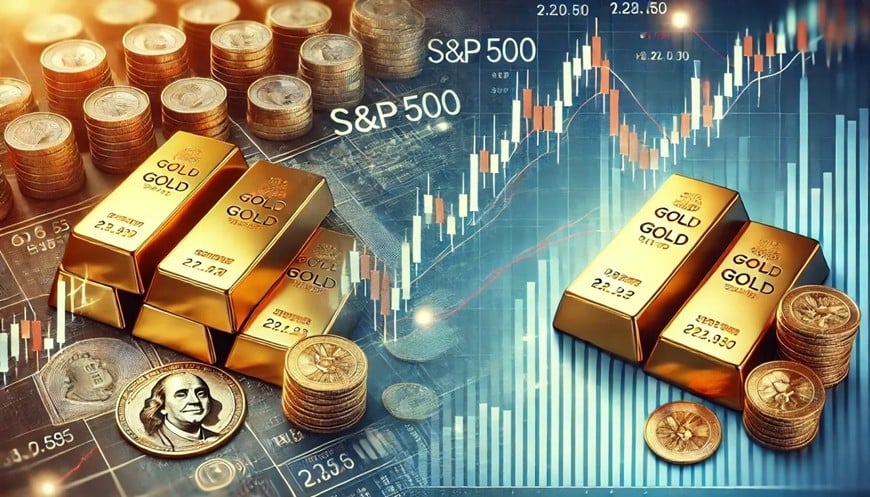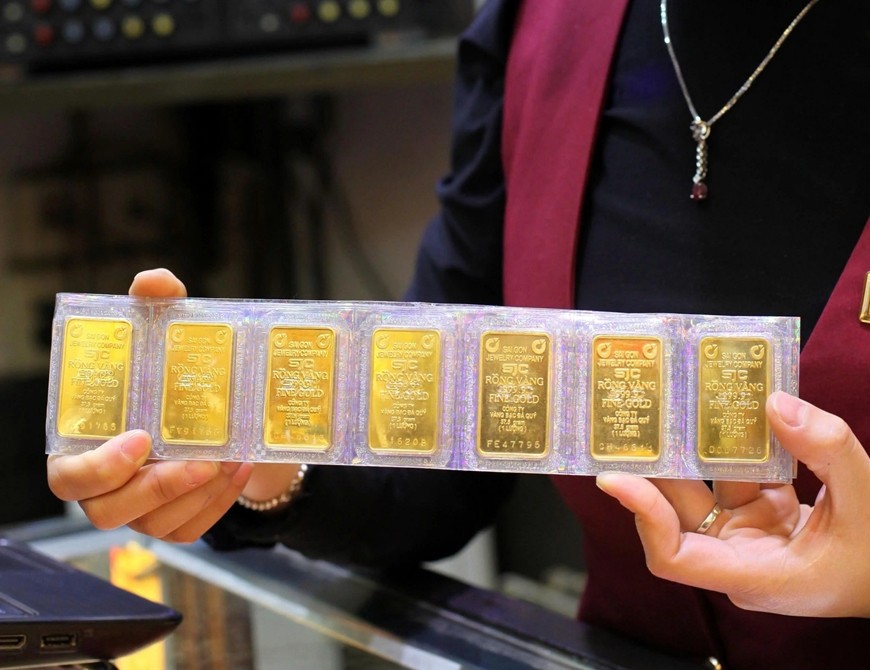At the end of the trading week, the spot gold price was anchored at 3,038.8 USD/ounce, down 46.9 USD compared to the closing price of the previous week, ending a 5-week streak of consecutive price increases for this precious metal.
The world gold market continued to fluctuate strongly this week, with prices increasing and decreasing by a large margin. Entering the new trading week, Gold prices soared to a record high of more than $3,100 an ounce, marking one of the strongest price increases in the history of the precious metal.
The rally was driven by a number of factors, including increased safe-haven demand due to concerns about the fallout from US tariff policies, strong demand from central banks, expectations of the US Federal Reserve easing interest rates, geopolitical instability in the Middle East and Europe, and increased inflows into gold-backed exchange-traded funds.

In the following trading sessions, the price of this precious metal fluctuated slightly and remained near the record high. In the last two trading days, the price of gold "plummeted" sharply, as investors rushed to take profits and close gold positions, to offset losses from other assets. At the end of the week, the price of gold was fixed at 3,038.8 USD/ounce, down 46.9 USD compared to the closing price of the previous session, ending the 5-week streak of consecutive price increases of this precious metal.
Accordingly, US President Donald Trump's trade tariffs have destabilized global trade and could cause a global economic recession. This has caused international financial markets to "shake" and precious metals, including gold, have also been affected.
Despite the sharp decline from last week, experts say gold is still significantly outperforming the stock market, with the S&P 500 down nearly 500 points, or 8.7%, from last Friday. The broader market index is experiencing its worst week since the global economy was shut down during the Covid-19 pandemic.
Tastylive.com chief strategist Chris Vecchio said it was no surprise that stocks saw such a sharp sell-off, as President Trump's global tariffs are causing the biggest disruption to global trade in 100 years.
Despite the decline in gold prices, Vecchio is optimistic that the factors that pushed prices above $3,000 an ounce remain strong and that the dip is still a buying opportunity. “In the long term, central banks will continue to diversify away from the dollar and into gold,” he said.
David Morrison, senior market analyst at Trade Nation, said that while the gold sell-off was stronger than expected, the move was not surprising, as momentum indicators showed prices were trading in overbought territory. However, he did not expect the rally to end, even if prices fell further.
The expert added that if gold prices consolidate around $3,000 or even $2,900 an ounce, gold could re-establish the moving average convergence divergence and create a basis for a new multi-year rally.
Experts and investors all agree that the recent sell-off is nothing to worry about and that the current factors supporting gold are still intact. Neil Welsh, Head of Metals at Britannia Global Markets, said that in the current context, gold prices are likely to return to new record highs.
Meanwhile, analysts said the Fed's neutral stance is negative for gold, as it supports higher bond yields and a stronger US dollar.
Speaking at a recent event in Arlington, Virginia, Fed Chairman Jerome Powell noted that the labor market remains fairly healthy and inflation risks continue to rise. The head of the world's most powerful central bank also emphasized that the Fed is monitoring the data before deciding what to do next.
While he believes gold could continue to fall in the short term, Naeem Aslam, chief investment officer at Zaye Capital Markets, said he remains bullish on the precious metal. Geopolitical tensions and inflation concerns remain strong, limiting the downside for gold. “I see gold as a buy on dips, especially if we see a pullback to key levels like $3,000 an ounce. Uncertainty is not going away – trade wars, central bank policy and geopolitical risks are all supportive of gold,” Aslam said.
The key news for the market next week is inflation data. Analysts say that the upcoming reports could impact the direction of this precious metal.

Similar to the developments in the world gold market, domestic gold prices continued to increase sharply in most trading sessions. In particular, on March 31, domestic gold prices increased "skyrocketingly", with gold bar prices increasing by VND1.1 million in both directions, up to VND99.5 million/tael for buying and VND101.8 million/tael for selling, respectively. Gold ring prices increased the most by more than VND1 million, up to around VND99 million/tael for buying and over VND101 million/tael for selling.
The price of this precious metal was adjusted up and down slightly in the following sessions before "plummeting" on April 5, with the price of gold bars losing 1.7 million VND in buying price and 1.2 million VND in selling price, the price of gold rings also decreased by more than 1 million VND/tael in both directions.
At 1 p.m. on April 5, the listed price of SJC gold bars was VND100.1 million/tael for sale. Currently, if converted according to Vietcombank exchange rate (excluding taxes and fees), the difference between domestic and world gold prices is about VND5 million/tael.
Source: https://baolangson.vn/gia-vang-tuan-toi-se-tiep-tuc-giam-5043257.html


![[Photo] More than 17,000 candidates participate in the 2025 SPT Competency Assessment Test of Hanoi National University of Education](https://vphoto.vietnam.vn/thumb/1200x675/vietnam/resource/IMAGE/2025/5/17/e538d9a1636c407cbb211b314e6303fd)
![[Photo] Prime Minister Pham Minh Chinh chairs meeting on science and technology development](https://vphoto.vietnam.vn/thumb/1200x675/vietnam/resource/IMAGE/2025/5/17/ae80dd74c384439789b12013c738a045)


![[Photo] Readers line up to visit the photo exhibition and receive a special publication commemorating the 135th birthday of President Ho Chi Minh at Nhan Dan Newspaper](https://vphoto.vietnam.vn/thumb/1200x675/vietnam/resource/IMAGE/2025/5/17/85b3197fc6bd43e6a9ee4db15101005b)






















![[Infographic] Numbers about the 2025 High School Graduation Exam in Dong Thap Province](https://vphoto.vietnam.vn/thumb/402x226/vietnam/resource/IMAGE/2025/5/17/c6e481df97c94ff28d740cc2f26ebbdc)


![[Photo] Nearly 3,000 students moved by stories about soldiers](https://vphoto.vietnam.vn/thumb/1200x675/vietnam/resource/IMAGE/2025/5/17/21da57c8241e42438b423eaa37215e0e)







































































Comment (0)